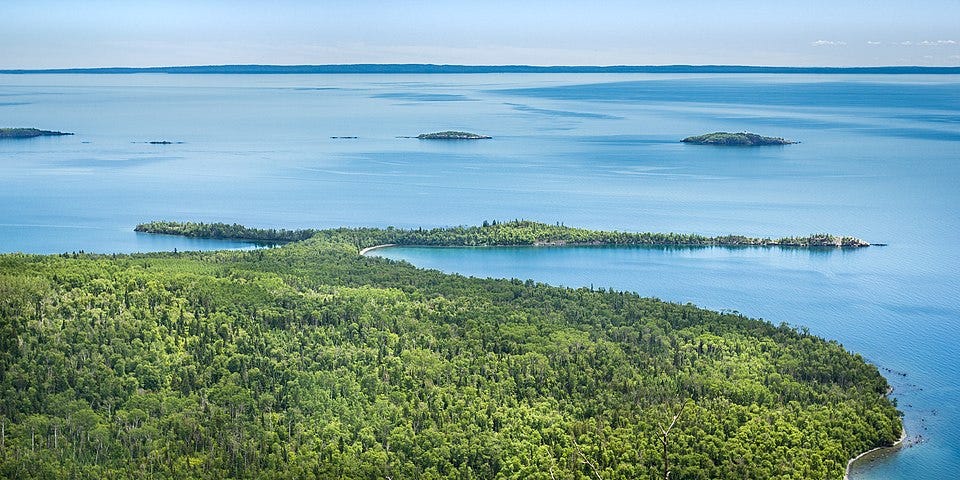
Above: Lake Superior, the third largest fresh water lake in the world by volume.
Climate Change
According to the United States Environmental Protection Agency:
In many areas of the [United States], climate change is likely to increase people’s demand for water while also shrinking water supplies. In mountainous and cold-weather regions, many people depend on snowpack for drinking water, agriculture, and other uses. “Snowpack” refers to the layers of snow that accumulate over long periods of cold weather. As it melts, snowpack feeds into streams and becomes an important freshwater resource.
In the West, warmer temperatures and changes in precipitation are reducing snowpack. In some areas, less snow is falling, as more precipitation is falling as rain rather than snow. Higher temperatures are also causing snowpack to melt earlier. All of these changes affect when and how much water is available.
This trend is unfolding worldwide.
Aquifer Depletion
According to Merriam-Webster, an aquifer is an underground layer that holds groundwater as a natural reservoir. Aquifers are being depleted worldwide, mainly to support agriculture.
According to USGS in 2018:
Groundwater is a valuable resource both in the United States and throughout the world. … In the United States, it is the source of drinking water for about half the total population and nearly all of the rural population, and it provides over 50 billion gallons per day for agricultural needs. Groundwater depletion, a term often defined as long-term water-level declines caused by sustained groundwater pumping, is a key issue associated with groundwater use. Many areas of the United States are experiencing groundwater depletion.
From the United Nations 2022 call for ending the overexploitation of water supplies:
The overexploitation of aquifers increases the vulnerability of drinking water supplies due to the scarcity of water during drought cycles, often forcing water to be supplied from further away, with a consequent price increase. Ultimately, such overexploitation of aquifers jeopardises the accessibility and affordability of drinking water in drought cycles, especially for those who live in poverty and situations of marginalization.
Pressure from Population Growth
Population growth is further straining global water supplies. According to an article from Water Footprint Network in 2024:
As we approach 2050, the global population is projected to reach 9 billion, according to [Organization for Economic Co-operation and Development] estimates. Concurrently, the demand for water is expected to increase by 55%, energy consumption by 80%, and food production by 60%. These surging demands will undoubtedly exert significant pressure on land use and resource management.
Remedies in Progress
A 2024 article from the United Nations Environment Programme lists some ways people around the world are contending with water shortages.
In Jamaica, using a rooftop collection system, farmers collect rain water in 6-1/2-foot-tall reservoirs that are connected to an irrigation for nearby crops.
In rural Chile and Peru, communities collect water suspended in the air, some using a fine mesh to trap tiny droplets of fog and syphon them into a reservoir.
Communities worldwide are considering treated waste water as a way to counteract local fresh water shortage. According to the Sewer Thermal Energy Network,
Cities like Tokyo and Vancouver are leading the way in using wastewater heat recovery systems … to provide heating for urban buildings. Singapore’s NEWater plants and Stockholm’s Hammarby Sjöstadsverket are prime examples of the integration of advanced treatment technologies, including MBRs and AI-driven optimization, into urban water management systems.
Desalination, a process that removes dissolved mineral salts from seawater, is used worldwide to bolster local water supplies. There are approximately 16,000 desalination plants in operation in 177 countries worldwide. Altogether they generate around 95 million cubic meters of fresh water daily.
The need for desalination grows as the world fresh water supplies dwindle. It may be a key to solving water scarcity in the future despite certain disadvantages that should not be overlooked.
The residue of the desalination process is brine - wastewater with a high concentration of salt and other pollutants. In many cases this residue is discharged into the sea where it affects marine ecosystems. This pollution can be at least partially offset by ‘brine mining’ - that is, extracting the minerals from the wastewater generated by desalination.
Conclusion
All is not lost, and there are existing possible solutions as well as new solutions that will come in the future. Nevertheless, it can’t hurt if we all do our part to be conscious about the preciousness of water and the factors that threaten its availability. It can’t hurt to choose water-saving shower heads, and to shut off the water when you don’t really need it running. And be careful about what you let go down the drain.
Pour yourself a nice cold glass of water on a hot day. Sip it slowly, consciously, and feel the joy in your body as it refreshes and rejuvenates you. Take the time to be grateful for water.



